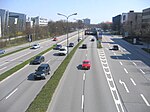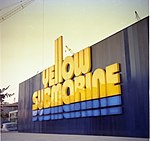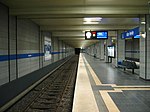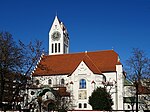Highlight Towers

Highlight Towers is a twin tower office skyscraper complex completed in 2004 in Munich, Germany, planned by architects Murphy/Jahn of Chicago. Tower I is 126 m (413 ft) tall with 33 storeys, and Tower II is 113 m (371 ft) tall with 28 storeys, which make them among the highest buildings in the city. The towers are joined by two skyways made of glass and steel. Also in the complex are two low-rise buildings between the twin towers, that serve as a hotel and additional office space. Overall, the facility offers approximately 73,836 m2 (794,760 sq ft) of office space. The towers are slightly shifted in the historic sightline of Odeonsplatz on Ludwigstraße with Victory Gate to the north and form a focal point for visitors coming from the north of the city.
Excerpt from the Wikipedia article Highlight Towers (License: CC BY-SA 3.0, Authors, Images).Highlight Towers
Mies-van-der-Rohe-Straße, Munich Alte Heide - Hirschau (Schwabing-Freimann)
Geographical coordinates (GPS) Address External links Nearby Places Show on map
Geographical coordinates (GPS)
| Latitude | Longitude |
|---|---|
| N 48.176666666667 ° | E 11.592222222222 ° |
Address
Highlight Towers
Mies-van-der-Rohe-Straße 6
80807 Munich, Alte Heide - Hirschau (Schwabing-Freimann)
Bavaria, Germany
Open on Google Maps










